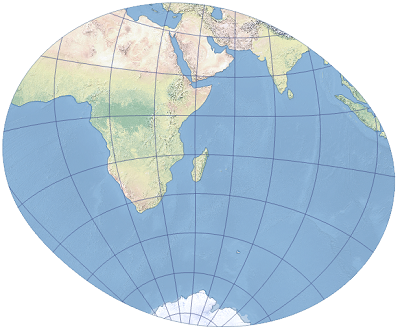Description
The Laborde projection is one version of the oblique Mercator projection derivations. It is used for conformal mapping of areas that are obliquely oriented and do not follow a north-south or east-west trend.
The projection's formulas were presented by Jean Laborde in 1926. It is available in ArcGIS Pro 1.0 and later and in ArcGIS Desktop 10.0 and later.

Projection properties
The subsections below describe the Laborde oblique Mercator projection properties.
Graticule
Laborde oblique Mercator is an oblique cylindrical projection. In general, the meridians and parallels are projected as complex curves. Only two meridians, exactly 180° apart, can be projected as straight lines, crossing the poles. Both poles are presented as a point inside the projection outline.
Distortion
Laborde oblique Mercator is a conformal map projection. It does not maintain true directions, but angles and shapes are maintained at infinitesimal scale. Distances are accurate along the central line if the scale factor is 1.0. If the scale factor is less than 1.0, there are two straight lines parallel to the central line with accurate scale. Area, distance, and scale distortions increase rapidly away from the central line or from two straight lines parallel to the central line.
Usage
The Laborde oblique Mercator projection is appropriate for mapping large-scale or smaller areas with oblique orientation that do not follow a north-south or east-west predominant extent. It is commonly used in Madagascar.
Limitations
The implementation of the Laborde oblique Mercator projection in ArcGIS is limited to show about two-thirds of a hemisphere around the center of the map.
Parameters
Laborde oblique Mercator parameters are as follows:
- False Easting
- False Northing
- Scale Factor
- Azimuth
- Longitude Of Center
- Latitude Of Center
Particular parameter cases
If the azimuth is 0° or 180°, the resulting projection appears as the transverse Mercator projection. Similarly, if the Latitude Of Center is set on the equator and the azimuth is either ±90°, the projection appears as the Mercator projection .
Sources
Geomatics Guidance Note number7, part 2: Coordinate Conversions and Transformations Including Formulas (2018). IOGP Publication 373-7-2.
Driencourt, L. & Laborde, J. P. (1932). Traité des projections des cartes géographiques à l'usage des cartographes et des géodésiens. Paris: Hermann et cie.
Projection Cartographique Gauss - Laborde (1995). Institut Geographique National. Available online: https://data.geopf.fr/annexes/ressources/documentation/geodesie/algorithmes/NTG_73.pdf [accessed on 25 September 2025].
Snyder, J. P. (1993). Flattening the Earth. Two Thousand Years of Map Projections. Chicago and London: University of Chicago Press.